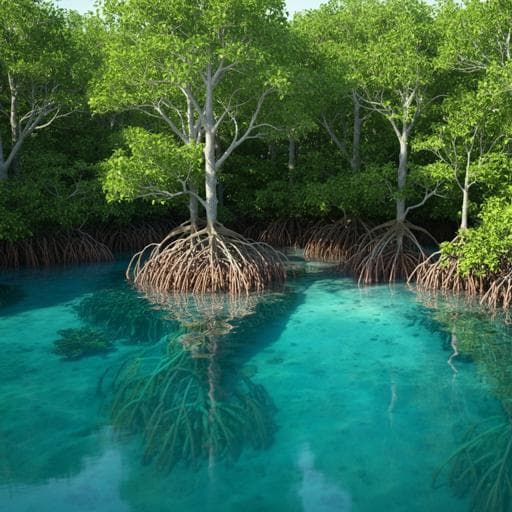
Environmental Studies and Forestry
Drivers of global mangrove loss and gain in social-ecological systems
V. Hagger, T. A. Worthington, et al.
This groundbreaking research by Valerie Hagger and colleagues explores the complex socioeconomic and biophysical drivers behind global mangrove loss and gain from 1996 to 2016. Discover how community forestry can foster expansion, while agriculture and aquaculture lead to significant loss, and learn about strategies to reverse this critical environmental challenge.
~3 min • Beginner • English
Introduction
Coastal ecosystems that support human well-being have declined due to human impacts and climate change, prompting urgent need for effective, scalable conservation strategies. Mangroves, present in 105 countries and valued for fisheries support, coastal protection, and carbon storage, have experienced substantial historical losses, including an additional 2.1% decline from 2000 to 2016, primarily due to conversion to aquaculture and agriculture. Governments and practitioners need to understand which social-ecological conditions reduce loss and increase gain to allocate scarce resources effectively. This study asks how national socioeconomic policies and governance, local economic pressures, and biophysical conditions interact to drive mangrove losses and gains, and whether these relationships have changed over time. Using a global dataset (1996–2016), the authors employ hierarchical modeling to link four measures of mangrove cover change (percent net loss, net gain, gross loss, gross gain) to national-level variables (e.g., community forestry support, restoration effort, NDC commitments, Indigenous land, Ramsar extent, democracy, economic complexity) and landscape-level variables (e.g., access to markets, economic growth), while controlling for biophysical drivers (fragmentation, sediment trapping, tidal amplitude, sea-level rise, drought, storms, temperature, and geomorphic type). The goal is to identify policy levers and local conditions that can reverse mangrove decline and promote recovery.
Literature Review
Prior work has shown that effective protected area management, strong governance, reduced corruption, and higher democracy levels can enable conservation outcomes. For mangroves, strong regulatory frameworks can mediate pressures from high population density and protect mangroves outside protected areas. However, rising biophysical pressures such as shoreline erosion and extreme weather events complicate conservation. In terrestrial forests, community forestry, Indigenous land tenure recognition, and climate policy programs have reduced deforestation. Community forestry initiatives in mangroves (e.g., Myanmar, Kenya) have been promoted to improve livelihoods and conservation, but their global-scale effects were unknown. Earlier global estimates suggested large historical mangrove losses and linked higher national income to higher loss during the 1990s, coinciding with aquaculture expansion. Advances in remote sensing have improved monitoring, yet gaps remain in integrating national policies with local economic and biophysical drivers at landscape scales. This study addresses these gaps by evaluating multi-scalar social-ecological drivers and their temporal shifts.
Methodology
Design and scope: The study analyzed global mangrove cover change over two decades, 1996–2007 and 2007–2016, using the Global Mangrove Watch (GMW) v2.0 dataset. Mangrove geomorphic units (n=4394 initial; mean size 33.63 ha) were delineated by maximal mangrove extent across 1996–2016 and classified into delta, estuary, lagoon, and open coast types. Units <1 ha were removed for mapping reliability; for modeling, units <100 ha were excluded to avoid inflated percent changes, yielding 3134 units across 95 countries. Units spanning countries were split by national boundaries. Response variables: Four primary responses were calculated per time period: percent net loss (net change <0), percent net gain (net change >0), percent gross loss (decrease unoffset by gains), and percent gross gain (increase unoffset by losses). Percentages were referenced to initial area and log-transformed; zeros were removed by separating net loss/gain and gross loss/gain. Where initial area was zero for net gain, 100% gain was assigned. Explanatory variables: National-level variables included community forestry (CF) support (country-level score based on counts of community/social forestry case studies and the presence of mangrove CF), mangrove restoration effort (number of restoration sites per country from collated databases/literature), inclusion of mangroves/coastal ecosystems in NDCs (scored from registry review), proportion of Indigenous peoples’ land, and Ramsar coastal/marine wetland area (scaled by 1996 mangrove area). Governance/economic indicators were democracy (V-Dem; at start of period) and economic complexity (ECI; at end of period). Landscape-level variables included market accessibility (travel time to nearest city, 2015), local economic growth (night-time lights change: 1996–2007; 2007–2013), and biophysical controls: mangrove fragmentation (clumpiness index per period), sediment availability proxy (sediment trapping index from free-flowing rivers linked to unit catchments), tidal amplitude (M2 from FES2014), antecedent sea-level rise (1993–2015 regional mean trend), drought severity (SPEI), tropical storm frequency (IBTRACS points within 200 km), minimum temperature of coldest month (WorldClim), and coastal geomorphic type. Statistical analysis: Multi-level linear mixed-effects models (lme4) were fitted for each response and time period with landscape-level and national-level predictors; country was included as a random intercept. Random slopes for travel time and night-time lights were tested via likelihood ratio tests; included if they improved fit. Variables were transformed as needed (e.g., log+1 for travel time, restoration effort, Ramsar; log for tidal amplitude). Collinearity screening (|r|>0.5) led to exclusion of EPI and MPA staff capacity indicators. Model fit was assessed by residual diagnostics; marginal and conditional R² reported. Spatial autoregressive (SAR) error models were explored (500 km neighborhood minimized AIC) but did not improve spatial autocorrelation over mixed models; thus, mixed models were used. Hotspots: For 2007–2016, hotspots were defined as units with percent net or gross loss/gain deviating by more than ±2 SD from the country mean. To reduce small-unit bias, units <50 km² were excluded from hotspot detection. Expert interpretation and satellite imagery were used to diagnose hotspot drivers and overlay with protected area data.
Key Findings
- Global trend: Net mangrove loss rate declined from 2.74% (1996–2007) to 1.58% (2007–2016), consistent with prior studies. Some countries exhibited net gains due to low gross losses and high gross gains.
- Access to markets: Shorter travel time to nearest city (greater market access) was associated with higher net loss in both decades (t=-2.21, p=0.03; t=-3.36, p<0.001) and higher gross loss in 2007–2016 (t=-2.59, p=0.01), implicating conversion to aquaculture and agriculture. The negative effect varied among countries and was weakly mitigated in more democratic/economically complex nations (non-significant). Market access was weakly associated with higher net gains in 2007–2016 (t=-1.92, p=0.06).
- Economic growth (night-time lights): Relationship reversed over time. Gross loss increased with higher night-time lights growth in 1996–2007 (t=2.05, p=0.04) but not in 2007–2016 (t=0.10, p=0.92). Net gains increased with night-time lights growth in 2007–2016 (t=1.96, p=0.05), suggesting that recent economic development may align with restoration/afforestation or natural regeneration.
- Community forestry (CF): Strong positive association with gains in 2007–2016 for both net gain (t=2.31, p=0.02) and gross gain (t=2.62, p=0.009). In contrast, higher gross losses were associated with greater CF in 1996–2007 (t=2.80, p=0.005), possibly reflecting CF policy responses to earlier deforestation. Thailand exemplified a shift from national net loss (−6.02%) to net gain (+1.11%) across decades amid extensive CF initiatives.
- Restoration effort and NDCs: Contrary to expectations, higher national restoration effort correlated with higher net loss in both decades (t=2.83, p=0.005; t=3.05, p=0.002) and higher gross loss in 1996–2007 (t=2.44, p=0.015), likely reflecting reactive policies in response to deforestation, underreporting/small-scale implementation, socio-legal challenges, and time lags. Gross loss was also higher in countries with stronger NDC commitment in 2007–2016 (t=2.20, p=0.028). Ramsar extent was not positively associated with conservation at national scale.
- Net and gross gains: Net gains occurred in 728 units across 64 countries (1996–2007) increasing to 1138 units across 80 countries (2007–2016). In 1996–2007, net gains were negatively correlated with clumpiness, antecedent SLR, and minimum temperature; nationally, net gains were positively associated with restoration effort but negatively with proportion of Indigenous land. In 2007–2016, net gains were positively associated with night-time lights growth and antecedent SLR, and nationally with CF effort. Gross gains were negatively related to democracy in 1996–2007, and to tidal amplitude and minimum temperature in 2007–2016.
- Biophysical drivers: Higher fragmentation (lower clumpiness) strongly increased both net and gross losses across decades (e.g., net loss t=-2.91, p=0.004; t=-3.52, p<0.001; gross loss t=-4.15, p<0.001; t=-8.00, p<0.001). Fragmentation also correlated with greater regeneration (net gain t=-5.51, p<0.001; t=-4.79, p<0.001; gross gain t=-23.08, p<0.001; t=-14.08, p<0.001). Increased sediment trapping (reduced fluvial sediment supply) raised gross loss in both decades (t=2.93, p=0.003; t=2.83, p=0.005). Smaller tidal amplitude was linked to higher losses for net and gross loss in both decades (e.g., net loss t=-5.17, p<0.001; t=-3.16, p=0.002). Severe drought (lower SPEI) and lower minimum temperatures increased losses in 1996–2007; gains were also higher in cooler minimum temperatures (indicative of post-disturbance regeneration). Net losses remained relatively high in lagoonal settings; gross losses were relatively high in deltas in 2007–2016 but often offset by high gross gains in deltas.
- Geomorphic type patterns: Lagoons showed relatively high net losses in 2007–2016; deltas exhibited higher gross losses but also substantial gains due to sedimentation and accretion, leading to offsets.
- Hotspots: Units with exceptionally high loss often reflected conversion to aquaculture/agriculture, sometimes within protected areas (e.g., Indonesia, French Guiana, Panama, Pakistan, Suriname, Thailand), suggesting management/enforcement challenges. Low-loss or high-gain hotspots were common in remote/inaccessible regions (e.g., Guinea, Mozambique, Micronesia). Some remote protected areas still experienced high loss due to natural sediment dynamics (e.g., mud waves in Amapá, Brazil).
Discussion
The study demonstrates that both socioeconomic and biophysical contexts jointly shape mangrove dynamics and that these relationships have evolved over the past two decades. A key insight is the temporal reversal in the association between economic growth and mangrove outcomes: economic expansion once correlated with increased loss but more recently aligns with gains, possibly due to improved wealth, education, and agricultural efficiency that reduce land-conversion pressure and enable restoration. Access to markets remains a strong predictor of deforestation pressure, underscoring the need to manage development and enforce protections near urban centers. The consistent positive influence of community forestry on gains in the recent decade highlights the potential of devolved, rights-based management and co-management to achieve conservation and livelihood benefits, particularly where tenure clarity and governance support exist. Conversely, correlations between higher national restoration/NDC commitments and higher losses likely signal reactive policy adoption in response to ongoing deforestation and the presence of reporting/time-lag biases and implementation challenges. Biophysical constraints—fragmentation, sediment deficits, and small tidal ranges—elevate loss risk, yet the same fragmented landscapes can also exhibit regeneration potential. Geomorphic setting matters: lagoons appear especially vulnerable to net loss, while deltas show high turnover with gains offsetting losses. Together, these findings address the central question by identifying policy levers (community forestry, co-managed protected areas, sustainable development pathways) and environmental contexts where interventions are likely to be most effective, while cautioning that governance capacity and enforcement remain critical near markets and in protected areas experiencing conversion pressures.
Conclusion
This global analysis links national policies, local economic pressures, and biophysical conditions to four complementary measures of mangrove change across two decades. The main contributions are: (1) evidence that economic growth’s relationship to mangrove change has shifted from driving loss to supporting gains in recent years; (2) strong support for community forestry as a driver of mangrove expansion; (3) identification of market accessibility as a persistent driver of loss; and (4) quantification of key biophysical constraints that elevate loss risk and modulate regeneration. Policy implications include scaling community/co-management models that secure local rights, focusing enforcement and land-use planning near urban markets, and integrating sediment management and landscape connectivity into coastal planning. Restoration and NDC commitments may require better targeting, financing, and timelines to translate into measurable reductions in loss. Future research should: (a) improve global sediment and shoreline dynamics datasets (including longshore transport and catchment erosion inputs); (b) evaluate causal impacts of specific policy instruments (e.g., CF program designs, tenure reforms, protected area enforcement) using quasi-experimental methods; (c) assess time lags between policy adoption and ecological outcomes; and (d) refine high-resolution socio-economic indicators beyond night-time lights for coastal zones.
Limitations
- Data constraints: Reliance on globally available datasets yields semi-empirical proxies for complex processes (e.g., sediment trapping index omits longshore inputs and catchment erosion increases). Governance indicators were missing for 46 mangrove countries (notably small islands), excluding them from modeling.
- Sampling/filtering: Units <100 ha were removed to avoid percent-change inflation; hotspots analysis excluded units <50 km². These thresholds reduce small-unit bias but may omit true hotspots and dynamics in small systems.
- Model design: Correlative mixed-effects models cannot prove causation; findings rely on expert interpretation. Spatial autoregressive models did not improve autocorrelation metrics over mixed models.
- Temporal coverage: Night-time lights data end in 2013; NDCs began near the end of the study period, limiting detection of policy impacts and introducing potential time lags.
- Policy measurement: Community forestry, restoration, and NDC indices may suffer from reporting bias, English-language bias, and scale/implementation variability.
- Sediment and morphodynamics: Global indices may inadequately capture local sediment budgets, subsidence, and shoreline processes affecting mangrove change.
Related Publications
Explore these studies to deepen your understanding of the subject.







